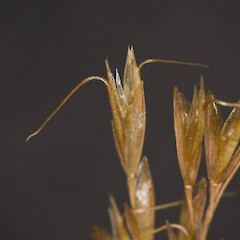Trisetum drucei
Common name
Druce’s oatgrass
Synonyms
None
Family
Poaceae
Flora category
Vascular – Native
Endemic taxon
Yes
Endemic genus
No
Endemic family
No
Structural class
Grasses
Chromosome number
2n = 28
Current conservation status
The conservation status of all known New Zealand vascular plant taxa at the rank of species and below were reassessed in 2017 using the New Zealand Threat Classification System (NZTCS) – more information about this can be found on the NZTCS website. This report includes a statistical summary and brief notes on changes since 2012 and replaces all previous NZTCS lists for vascular plants.
Please note, threat classifications are often suggested by authors when publications fall between NZTCS assessment periods – an interim threat classification status has not been assessed by the NZTCS panel.
- Conservation status of New Zealand indigenous vascular plants, 2017 . 2018. Peter J. de Lange, Jeremy R. Rolfe, John W. Barkla, Shannel P. Courtney, Paul D. Champion, Leon R. Perrie, Sarah M. Beadel, Kerry A. Ford, Ilse Breitwieser, Ines Schönberger, Rowan Hindmarsh-Walls, Peter B. Heenan and Kate Ladley. Department of Conservation. Source: NZTCS and licensed by DOC for reuse under the Creative Commons Attribution 4.0 International licence.
2017 | At Risk – Naturally Uncommon | Qualifiers: DP, RR, Sp
Previous conservation statuses
2012 | At Risk – Naturally Uncommon | Qualifiers: RR, Sp
2009 | At Risk – Naturally Uncommon | Qualifiers: DP
2004 | Sparse
Distribution
Endemic. North Island from Mt Wharekia, East Cape south to near Taihape. In the South Island in North West Nelson, and eastern Marlborough from the Waima River south to North Canterbury (Parnassus).
Habitat
A cliff dwelling species preferring calcareous mudstones, siltstones, sandstones, and marble and limestone. Occasionally on greywacke and ignimbrite rock. On these rocks it is usually found growing in seepages.
Detailed description
Dense, tufted grass up to 600 mm with culms usually overtopping the dense, finely scabrid leaves; branching intravaginal. Leaf-sheath 20–80 mm, firmly membranous, grey-brown to light greenish brown, sometimes reddish, very densely minutely papillose or minutely scabrid to pubescent, rarely glabrous. Ligule 0.8–1 mm, truncate, erose, sparsely finely ciliate. Collar sometimes with a few stiff hairs up to 1.5 mm. Leaf-blade 30–300 × 0.5–4 mm, dull green, glaucous or reddish, folded with inrolled margins or flat, firmly coriaceous, abaxially scabrid with dense prickle teeth, or smooth, or sparsely scabrid above, adaxially ribbed with minute prickle-teeth or densely pubescent on ribs; margins scabrid. Culm 100–400 mm, internodes glabrous or finely pubescent above, sometimes pilose, or minutely prickle-toothed below panicle. Panicle 50–200 × 10–30 mm, lanceolate, with short branches, more or less interrupted, not very dense, sometimes quite open; spikelets clustered and individual inconspicuous; rachis, branches and pedicels densely but minutely strigose or puberulous. Spikelets 6–8 mm, light green (often tinged reddish brown). Glumes unequal, membranous, keels with minute prickle-teeth in upper half; lower glume ¾ length of upper, narrow oblong to narrow ovate, upper glume ¾ to almost equal the length of the spikelet, elliptic oblong; margins broadly hyaline, sparsely prickle-toothed near the acute, acuminate or rarely mucronate apex. Lemma 3.5–6 mm, bidentate or bicuspid, papillose, minutely prickle-toothed near midnerve; awn 3.5–7.5 mm, recurved, insertion in upper ¼ of lemma. Palea minutely prickle-toothed on keels and on margins near apex. Callus hairs up to 1 mm. Rachilla hairs up to 2 mm. Lodicules 0.8–1.2 mm, glabrous. Anthers 0.8–2 mm. Ovary 0.8 mm; stigma styles 1.2 mm. Seed 2.5-3 × 0.7–0.8 mm.
Manaaki Whenua Online Interactive Key
Similar taxa
A distinctive species usually inhabiting damp seepages on cliff faces. It is somewhat similar to Trisetum antarcticum (G.Forst.) Trin. in possessing intravaginal innovation shoots, and superficially similar in overall appearance to the more usually coastal T. arduanum Edgar et A.P.Druce. From both it differs through a combination of the having a dense tufted habit, more open, interrupted, though not very dense, lanceolate panicle, which is in turn shortly-branched throughout; and also by the leaf-blade which is densely to weakly, and always minutely, scabrid.
Flowering
October–February
Fruiting
December–May
Propagation technique
Easy from fresh seed and rooted pieces but short-lived. A very attractive grass, with does best in a sunny aspect overlying damp soil.
Threats
Not threatened but rather uncommon and sporadic in its distribution.
Etymology
trisetum: Three-bristled
drucei: Named after Anthony (Tony) Peter Druce, one of New Zealand’s most respected field botanist (1920-1999).
New Zealand Botanical History
For a brief biography of A. P. (Tony) Druce, the person after whom this plant is named, see this article in Te Ara - The Encyclopedia of New Zealand. Hundreds of Tony’s famed plant lists can be found here and back-issues of regional Botanical Society Journals to which he contributed can be accessed here.
Attribution
Description modified from Edgar and Connor (2000).
References and further reading
Edgar E, Connor HE. 2000. Flora of New Zealand. Vol. V. Grasses. Manaaki Whenua Press, Christchurch, NZ. 650 p.










